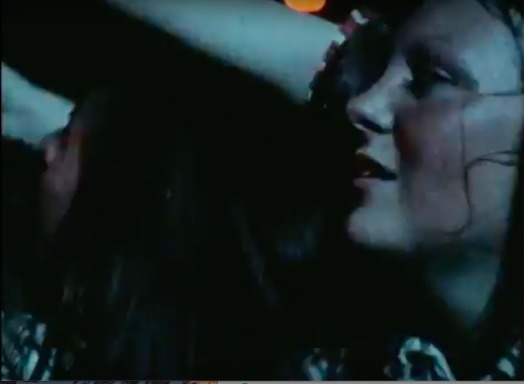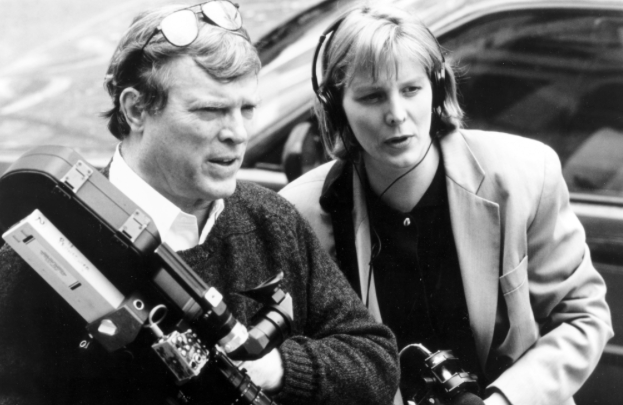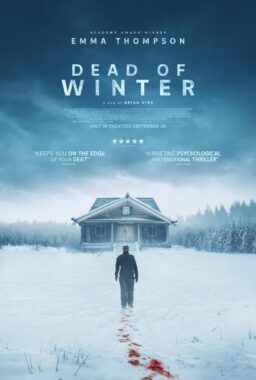D.A. Pennebaker, who died last week at 94, was one of the great documentarians, and one of the great cameramen in the history of movies.
If you’re a student of how images are captured on film, and if you pay attention to the personality of those images, you get to the point where you can spot a Pennebaker shot. It’s active, it’s searching, it’s restless. It’s never inattentive to what’s right in front of it, but at the same time, it is constantly aware of the entire room. That’s what made all of his documentaries—and he made an incredible number of them—so distinctive. He’s always telling the story of individuals or small groups of people, but at the same time, he’s keeping track of the cultural context in which the events are occurring, and the space or stage itself.
One example can be found in the 1993 documentary “The War Room,” about Bill Clinton’s Democratic campaign for president. There is a moment near the beginning [see above screenshot] where a campaign staffer is addressing the troops. Pennebaker cuts to a man sitting on a couch amid the throng of campaign workers, asking a question. The shot is framed so that we see a little girl leaning on the couch behind him blowing up a red balloon. Another documentarian might have zoomed in for a closeup of the man asking the question, but Pennebaker lets you see this mundane kind of comical detail. It’s probably just the daughter of somebody who works on the campaign. But it’s a touch that instantly communicates how this kind of work is at once historically momentous but also just another thing adults do, sometimes with their children in tow. Later in the film, there’s a campaign event where the scene begins with a long medium shot of a woman in a pink blouse with glasses providing the sign language interpretation of the song “Domino.” Again, it’s not the obvious way to start a scene like that. But it’s characteristic of how Pennebaker often tries to sneak into a moment sideways, more like a feature writer than somebody trying to deliver breaking news.
I think it’s really important to mention Chris Hegedus here, his wife and filmmaking partner for the second half of his career. Pennebaker’s movies might have changed a little bit once she came on board. We got a more insistent sense of the wider canvas when they started working together, whereas Pennebaker’s earlier films, particularly his breakthrough Bob Dylan documentary “Dont Look Back,” were hyper-focused on individuals and the rooms they happened to be in. Once he opened out a bit, you got stuff like the Pennebaker-Hegedus films “Moon Over Broadway” and “Elaine Stritch at Liberty,” both of which are vivid portraits of legendary female stage stars—respectively, Carol Burnett and Elaine Stritch—that also give you a sense of what Broadway was like in the late 90s and the aughts, and all the financial forces involved in bringing productions to life, as well as artistic ones.
Pennebaker got started as one of the founders of what was later called the Direct Cinema movement, which is essentially a fly-on-the-wall approach to documentary filmmaking that didn’t do talking heads and explanatory charts and graphs. It just put you in the room where it happened, to quote “Hamilton.”
I was fortunate to be able to spend a number of days with the architect of that school of filmmaking, Robert Drew, who came out of the Air Force where he was in the film unit and joined Time-Life’s newsreel division. Pennebaker worked with him and they decided that the way that documentaries were being made at that point—often with rather bulky 35mm cameras—was not helping the art form evolve. They wanted to be more agile.
So Drew and Pennebaker soldered together a makeshift 16mm sync-sound camera. I got to hold this camera when I visited Drew in his Brooklyn home in 2004. It was amazing. You could see where they had fused parts from different cameras. You could see the places where the metal was scarred from the blowtorch. The scars weren’t elegant. They suggested remnants of battlefield surgery performed with whatever implements were handy. The operator could hold this camera on one shoulder, and there was a cable leading out of the camera that connected to a bulky sound recorder on the cameraperson’s hip. The entire package was quite heavy. Eventually, they figured out how to fuse sound equipment to the camera itself so it wasn’t two separate pieces on different sides of the cameraperson’s body.
American documentary cinema was really off to the races once they figured all this stuff out. What these technical advances meant was a documentary cameraperson could now be in the crowd, in the back of a room somewhere, shooting with a zoom lens that allowed them to get close to people’s faces without being actually “in” their faces, while getting usable sound even if the subject wasn’t speaking into a microphone. If you had a light on top of the camera that was aimed up at the ceiling, you’d get a nice, soft, all-over illumination so that you wouldn’t have to set up lights on stands that people might bump into or block, and that would make them more self-conscious than they already were.
What all of this was about was making people less sensitive to the fact that they were being filmed. That was Direct Cinema’s major advance, aesthetically as well as technically. If you sit somebody down in a chair and point a camera at them and spend 30 minutes lighting them, you’re going to get a different performance, for lack of a better word, than if you’re standing 20 feet away filming them with a zoom lens as they’re talking to a room full of people.
Robert Drew’s pioneering Direct Cinema films “Primary,” which centers on John F. Kennedy in the run-up to the 1960 Democratic primary in Wisconsin, and “Crisis,” about school integration in the South, inaugurated this bold new phase of nonfiction cinema. “Crisis” would not have existed had Kennedy not had a positive experience with Robert Drew and his team on “Primary.” He thought of them as historians who were there to record the important moments, and he told Drew that he forgot that the camera was there.
Pennenbaker brought that Direct Cinema eavesdropping quality to music documentaries – a lot of them. He made “Dont Look Back,” filmed in 1965 but released in 1967, giving us probably the first anti-heroic asshole intellectual rock star in cinema, with Dylan playing a smart-ass Socrates with a guitar, engaging people in dialogues all the way through the film and sometimes cutting them up verbally for sport. Dylan was so bold, even cocky, that he might have given a comparable performance in the movie even if the camerawork had been obtrusive.

Still, I have to imagine that Pennebaker’s philosophy facilitated access to Dylan at his Dylan-est—a sneakily assured, wily character with an anarchic streak, always angling to see what he could get away with. Dylan was constantly performing for Pennebaker’s “invisible” camera, and Pennebaker saw that and got it. Which means that when you watch the movie, you get a rock star acting like he doesn’t know the camera is there when he actually does, and Pennebaker’s camera recording a highly conceptual performance by a person who pretends he doesn’t know he’s performing, seeing through Dylan even while allowing him to have his moment. The invisible actor and the invisible director are in cahoots even as they practically draw tiny marginal arrows that tell observant viewers what’s actually happening. There are about five different levels to this film. Pennebaker captured them all, without making a huge deal of the fact that he was hip what was occurring.
There was a musicality, or almost dancer-like sensibility, to Pennebaker as a cameraperson. I always got the sense that he was most excited being where the action was, whether the action was physical, artistic, intellectual, or all three. If that meant the scene was about people talking, then that’s where his focus was. But when people were singing and playing instruments, something extraordinary happened for him, and to him. I think he became his fullest self when photographing performers. That might be the one thing that all of his major subjects have in common, whether they’re rock stars, politicians and political advisors, actors or chefs. And this becomes most obvious when he’s pointing his camera at musicians, who are singing, dancing, acting, telling a story, and often trying to persuade, in some sense, all at the same time.
After “Don’t Look Back,” Pennebaker did the unreleased “Something is Happening,” also a Dylan movie, and “The Document,” which got a limited release in 1966. Then came “Monterey Pop,” which everybody remembers the famous shot of Jimi Hendrix burning his guitar on stage, but it’s more important as probably the first major theatrical documentary to give you a sense of the full breadth of what was going on in western pop music in the 60s, not just focusing on one artist or one band, but the totality of it.

And it also gave you a picture of how the audience related to these musicians. Pennebaker and his crew made sure to pay attention to the people who were watching and listening to the concert, not just the performers themselves. And he showed you the behind-the-scenes collaborators who put on the show: the stage crew, the roadies, the managers. An entire tradition of music documentary comes out of Pennebaker, and he brought the insight he gleaned covering rockers to Broadway in “Original Cast Album: Company,” a project that was unprecedented. Prior to its release, I can’t really think of another documentary where the crew just watches a bunch of people record an album, refining the work and negotiating their way through rough spots.
Pennebaker does this thing where he always seems to be anticipating the next moment. He stays on the most interesting thing he can find until he feels like, if he doesn’t move, the scene is going to be less interesting. It takes incredible focus to shoot that way because you have to be listening to the rest of the space as well as looking through the lens of the camera (or into the monitor). Say there’s a conversation between two people and you’re covering one of them in close-up. You have to know where the other person is so you can move to get their reaction at the exactly right moment and nail it technically as well as emotionally. You can’t overshoot. You can’t have the camera pass the other person, or land on their elbow instead of their face. It’s high-pressure because if you’re capturing what you know is a wonderful moment, you want it to be more than just usable; you want it to be perfect. It’s a high-wire act comparable to a great guitar player nailing a solo when the band is really cooking. It’s a physical skill, this sort of camerawork. It’s athletic.
You see Pennebaker’s athleticism in that “Company” documentary. And you see it in “Ziggy Stardust and Spiders from Mars” from 1973, which has an amazing section in the middle where the entire thing is illuminated by a strobe light. You’re seeing these impressionistic flashes of Bowie and the other performers on stage, and you’re also seeing the audience, rapt with their outstretched hands and their tearful faces like they’re witnessing Jesus coming back. It’s a great example of how you can make something visually beautiful without being “pretty,” without it being affected, and without losing track of the thing you’re photographing, losing its soul, and letting it turn into an object.

Pennebaker exuded vitality throughout his long career. This was a man who was of the World War II generation, and he not only continued to make movies until he entered his 90s, he continued to be actively involved in those movies. He wasn’t nodding benevolently from the sidelines. He wasn’t sub-contracting the work to anyone else and putting his name on it. He was in the middle of it, where the action was. If you look at later works like “The War Room”; “Moon Over Broadway”; “Down from the Mountain” a documentary that was about the making of a live concert of music from “O Brother, Where Art Thou?”; or “Kings of Pastry,” about a competition of French pastry chefs, you see the same nimble, intelligent eyes and ears that dazzled movie buffs in 1967 with “Don't Look Back.”

Pennebaker and Hegedus were ego-free when it came to helping other filmmakers. The list of younger filmmakers who were mentored or simply helped by them in moments of need is endless. It includes the makers of “Documentary Now!”, who just aired a meticulous parody of Pennebaker’s “Company” documentary. A couple of the producers told me that Pennebaker and Hegedus not only advised on the production of the “Company” parody, they were intimately involved. The “Documentary Now!” crew would email Pennebaker and Hegedus and ask technical and historical questions, and they would go into the archives and tell them what kinds of lights they used, what kinds of film stock they used, how they recorded the sound. Everything. They were honored that Pennebaker’s work was being scrutinized so lovingly, decades after its initial release.
I interviewed Albert Maysles, another one of the giants of Direct Cinema, in 2000. He talked at length about all of his influential peers. At the time he had just been named one of the greatest cinematographers in the history of movies by Kodak, for a commemorative “100th Year of Cinema” poster that had thumbnails of 100 cinematographers. He pointed to himself on the poster, and said with pride that it was the only picture that was out of focus. He was proud of that, because, as he went on to explain, in Direct Cinema, technical perfection was not the most important thing. It was about being there in the moment, and finding the right shot for that moment.
I asked Maysles, “Out of all the people involved in creating this particular school of nonfiction cinema, who would you say was the best at it?” He said “D.A. Pennebaker, without question.”












